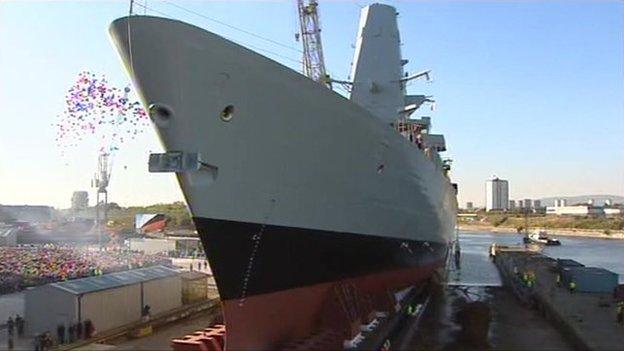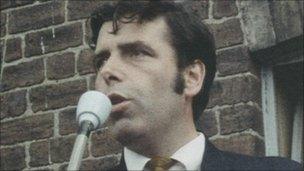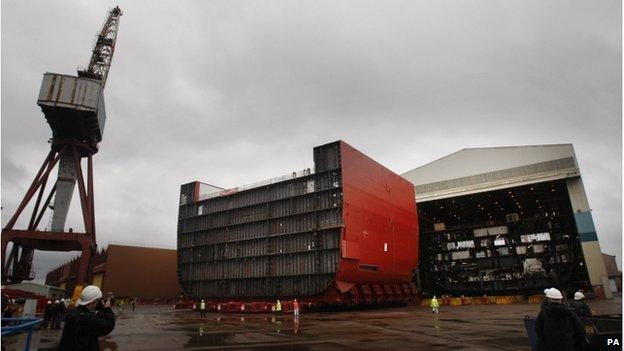Govan: A shipbuilding history
- Published

The Govan shipyard has been at the heart of Scotland's industry for 150 years
Scotland was once the shipbuilder to the world and the heart of its industry was sited on the south bank of the River Clyde in the Glasgow district of Govan.
It was the famous Fairfield yard which took the Upper Clyde to great heights and worldwide prominence.
The yard was founded in 1864 by William Elder, a talented marine engineer who developed the compound engine which transformed shipbuilding by allowing vessels to use fuel more efficiently and travel further.
Under William Pearce from 1888, the company flourished, building luxurious ocean liners, steamers and naval ships for the world.
At its peak before World War 1, the Fairfield shipyard was part of a local industry which directly employed 70,000 workers in 19 yards.
The largest crane in the world, with a maximum lift capacity of 250 tons, was built at the Govan yard in 1911 and in the following year Fairfield had 12 ships under construction at the same time.

The sixth and last of the Royal Navy's new Type 45 Destroyers was launched in Govan three years ago
The inter-war years saw a gradual decline but Clydeside's largest shipyard still built many famous ships and during wartime it was a major builder for the Royal Navy.
But after World War 2, the decline set in swiftly and despite a major modernisation programme in the 1950s the yards of the Clyde were unable to compete with new shipbuilding superpowers such as Japan.
By 1967 the receivers were called in and it looked as if the end had come for Fairfield and for shipbuilding in Govan.
Sean Connery, at the height of his James Bond fame, made a documentary about problems besetting the yard, entitled The Bowler and the Bunnet.
Among the footage of a community on the edge of oblivion was Connery riding a bicycle around empty shipyard fabrication sheds.

Jimmy Reid's speech to shipworkers was broadcast around the world
The UK government's response to the crisis was to create the Upper Clyde Shipbuilders (UCS) in 1968, which had about 8,500 workers in five yards - Fairfield's and Stephens on the south bank, Connel's and Yarrow's on the north bank, and John Brown's at Clydebank.
In 1971 UCS went into receivership and was refused a government loan. This led to one of the most famous episodes in industrial history - the work-in.
The unions, led by Jimmy Reid and Jimmy Airlie, occupied the yard and made a demand of the then Conservative prime minister Edward Heath for the "right to work".
In February 1972, the government agreed to retain two yards, Yarrow at Scotstoun and Fairfield's at Govan.
Fairfield's was formed into Govan Shipbuilders in 1972, which was itself later nationalised and subsumed into British Shipbuilders in 1977.
The government of Margaret Thatcher broke up British Shipbuilders and denationalised it in 1988, when the former Fairfield yard was sold to the Norwegian Kvaerner group.
Kvaerner took the yard through another modernisation programme to enable it to specialise in the construction of liquefied natural gas and chemical tankers.

A section of the hull of HMS Queen Elizabeth being moved at BAE Systems' Govan shipyard
But in the late 1990s, the market became depressed and the yard had to find alternative contracts.
The yard passed to BAE Systems in 1999 and has found work over the past decade making destroyers and aircraft carriers for the Royal Navy.
BAE is a key partner in the construction of the two Queen Elizabeth class aircraft carriers being built at the Portsmouth yard and in Scotland.
However, after their construction is complete, there is only expected to be the need for one centre for naval shipbuilding in the UK to build the next generation of Type 26 frigates.
The Clyde aircraft carrier work is due to finish in 2015. It is still not clear where Type 26 frigates will be built. There are no other orders on books.
Could the sun be setting on a long tradition of Govan shipbuilding?
- Published2 November 2013
- Published25 November 2012
- Published11 October 2010